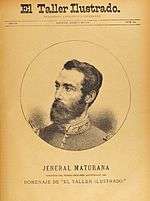Marcos Segundo Maturana
Marcos Segundo Maturana Molina (February 15, 1830 – May 18, 1892) was a Chilean military and art collector. Given his service in the War of the Pacific against Peru and Bolivia he is regarded a war hero by the Chilean army. Maturana is known for organising the National Museum of Paintings of Santiago, currently known as the National Museum of Fine Arts of Santiago de Chile.
General Marcos Segundo Maturana Marcos Segundo Maturana | |
|---|---|
| Birth name | Marcos Segundo Maturana Molina |
| Nickname(s) | Maturana General |
| Born | February 15, 1830 Santiago of Chile |
| Died | May 18, 1892 Santiago of Chile |
| Allegiance | Chile |
| Service/ | Chilean's Army |
| Years of service | January 4, 1883 - July 23, 1889 |
| Rank | General of Chile |
| Unit | Mayor General |
| Commands held | 1851 Chilean Revolution War of the Pacific |
| Battles/wars | Urriola Mutiny Battle of Miraflores Battle of San Juan and Chorrillos |
Family and studies
He was the eldest son of independence era general Marcos Maturana del Campo and Francisca Molinas Berben; Single and without offspring. He studied at the Núñez School in Santiago, Chile. On Saturday, July 2, 1844 at age 14 he entered the Military School.[1]
Military career
On September 18, 1848 he was awarded the rank of Sub-Lieutenant of Artillery. On April 20, 1851, in the so-called Urriola mutiny he defended the headquarters of Artillery of Santiago, under the orders of his father. In this case, he was seriously injured in the chest. For his conduct in these events, he was granted the ascent of Captain, and later, in 1854, he was promoted to Sergeant Major
In 1858 he had health problems and in 1861 he rejoined the army. In October of that year he was appointed first assistant of the General Inspection of the National Guard and in 1862 he became a lieutenant colonel.
On September 25, 1865 he assumed as Commander of Arms of the Constitution and later on November 16 he was appointed Governor of the Constitution and participated in the war against Spain, defending the coast of the province of Talca.
On February 28, 1866 he assumed as commander and organizer of the 11th Line Battalion and participated in the Araucanía campaigns.
July 12, 1867 he was appointed by President José Joaquín Pérez, his Aide-de-camp. Later in 1869 he was Aide-de-camp of President Federico Errázuriz Zañartu and before the War of the Pacific he was Aide-de-camp of President Aníbal Pinto Garmendia.
In 1868, he was a member of the Commission that repatriated the remains of the father of the Chilean homeland, General Bernardo O'Higgins.
May 15, 1879, he was appointed General Director of the Maestranza and Artillery Park and on October 1, of the same year he was appointed Commander of the forts and batteries of Valparaíso. Shortly after he resumed command of the Maestranza de Santiago and it was his responsibility to quell the fire that occurred in these facilities on January 27, 1880.[2]
War of the Pacific

The war of the Pacific began and on August 27, 1880 he was promoted to brigadier general. On September 29 of the same year he obtained the appointment of Chief of the General Staff, rank with which he participated in this war.
He was with José Francisco Vergara, where they participated in the battles of Chorrillos and Miraflores on January 13 and 15, 1881.
In 1881, he returned to Chile and returned again to the direction of the Maestranza. On June 14 of the same year he was appointed Commander of the forts and batteries of Valparaíso and on July 31, 1881 he organized the National Museum of Paintings of Santiago, currently known as the National Museum of Fine Arts of Santiago de Chile.
On January 4, 1883 he ascended to General of Division and in 1889, on July 23, he retired from the Chilean army.[3]
Legacy
Maturana General for years he dedicated himself to the acquisition of works of art such as ancient weapons, Inca archeological pieces, European porcelain, cologne items and paintings of different Chilean and foreign painters.
On July 31, 1880, together with the Florentine Juan Mochi, the sculptor José Miguel Blanco and the young painter Enrique Swinburn Kirk, the beginnings of the National Museum of Paintings, which had been formed with 140 works of art. This museum was inaugurated on September 18, 1880, becoming part of the Chilean patriotic festivities of this year.
He was a brave soldier with natural ability. He had served in the campaigns in which he participated, excelling in the war actions of 1851 and 1880, which made him ascend rapidly on the military staircase; this allowed him to occupy important military positions.
He remained forever in Chilean memory as one of his war heroes. Art was his great passion and the "Institute of the Public Instruction Council" received the Maturana General Prize in 1882 that lasted until great economic depression of 1930.[4]